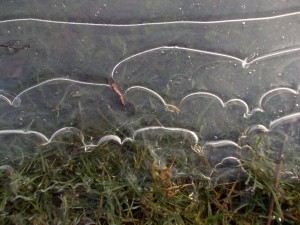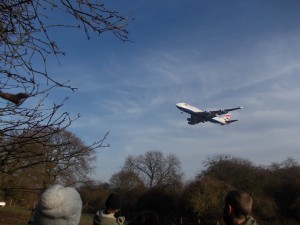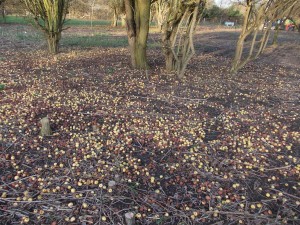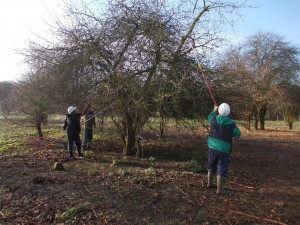
I arrived at Huckerby’s Meadows in the crisp early morning. No, I hadn’t heard of it either: it was round the back of the industrial estate at Cranford, squeezed in between the edge of London and the perimeter of Heathrow airport. The puddles were interestingly frozen, the looping pattern suggesting successive stages of freezing.

The meadows have miraculously survived untouched by the rushing development all around them. In fact, it protected them – nobody wants to live exactly under the end of the flight path, just before the planes drop over the airport fence and shriek to a halt on the runway; and the airport itself may well have had designs on the land, buying it up just in case, but not sure what to do with it. Huckerby’s meadows are now leased by the airport authority to London Wildlife Trust. It discovered a hidden corner of England, taken over by wildlife: I saw muntjac deer prints, jays, a green woodpecker, mallard ducks, a singing song thrush, and fieldfares chattering in the hedges.

The meadows had become seriously overgrown with brambles, creeping across the grass from the hedges. Volunteers have now cleared most of them, revealing a curious sight: the meadows contain a large number of big, old crab apple trees in their midst, nowhere near the hedgerows, so they must have been there for a purpose. A possible clue is in the carpet of fallen crab apples: perhaps old Huckerby found them useful fodder for his pigs? The crab is so sour that it is barely suitable as human food – crab apple jelly about covers it – but pigs will eat them as a change from the swill they were presumably fed on, in those days.
We volunteers had been lucky enough to get a place on a fruit tree pruning course, run jointly by London Wildlife Trust and the London Orchard Project. The course tutor, Bob, had come down from Norfolk to get us up to speed. The pole saws we had to use were remarkable, extending to 12 foot long, with a viciously sharp curved saw at the far end – think of the scythe in the hands of the black-cowled figure of Death, and you have the general idea. Bob effortlessly lopped off an offending branch ten feet above his head. We wore awkward goggles and hard hats; fresh, sharp-edged sawdust falling in your eyes means an instant visit to casualty, and of course as you saw something and look up, that’s just where the stuff is going to fall.

Bob explained remedial pruning; you don’t want ‘a tree on top of a tree’, a new vertical shoot rising from the end of an exposed branch, or the tree will get topheavy and split. You can’t just hack away: the tree will go into emergency overgrowth mode if you cut away more than 20% of the branches in a year. If an individual branch is heavy, just slicing away from the top means it will split when you are halfway through, letting wet and fungi into the wound, so it is best to cut in stages, reducing the weight by cutting smaller branches further out. Then you can cut the main branch part-way through from the bottom, finishing off from the top for a neat job, a cut surface that will shed rainwater cleanly. And you want to shape the tree neatly, with no crossing branches: they should radiate out tidily, giving each other space. Suddenly there was a lot to think about, and we looked at trees with newly informed interest. Then it was time to try it for ourselves. It was a lot harder than watching Bob do it; the poles were tricky to manoeuvre through the tangle of branches, the sun was in our eyes, and sawing at a distance felt nothing like holding a handsaw. But with supervision and encouragement we got the hang of it, and were soon bringing sizeable lumps of wood safely down to earth.
Bob also answered our questions about fruit trees – I needed something to pollinate my Cox’s Orange Pippin apple as it wasn’t bearing much fruit. The pollinator needs to be a suitable variety, so the flowers are open at the same time and the pollen is not rejected as being the same – Coxes do not self-pollinate. Lord Lambourn, for instance, is a good choice, as it is a useful cooking apple to complement the sweet eating Cox, and the two varieties pollinate each other as the bees fly about the garden visiting flowers.
By the end of the day, I had learnt a great deal, realising that I was only just beginning to grasp the rudiments of a fascinating subject. Maybe I’ll try grafting next year.
